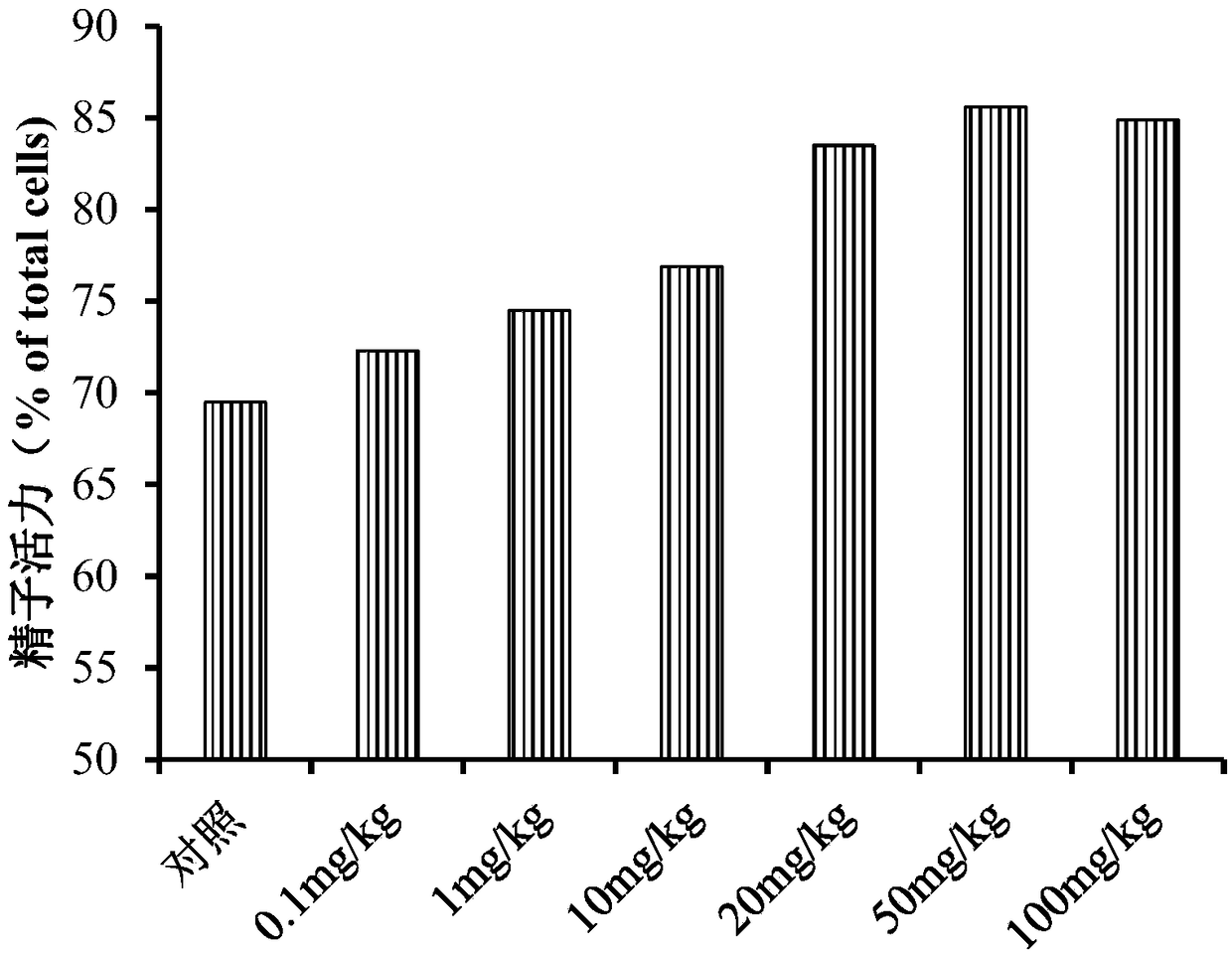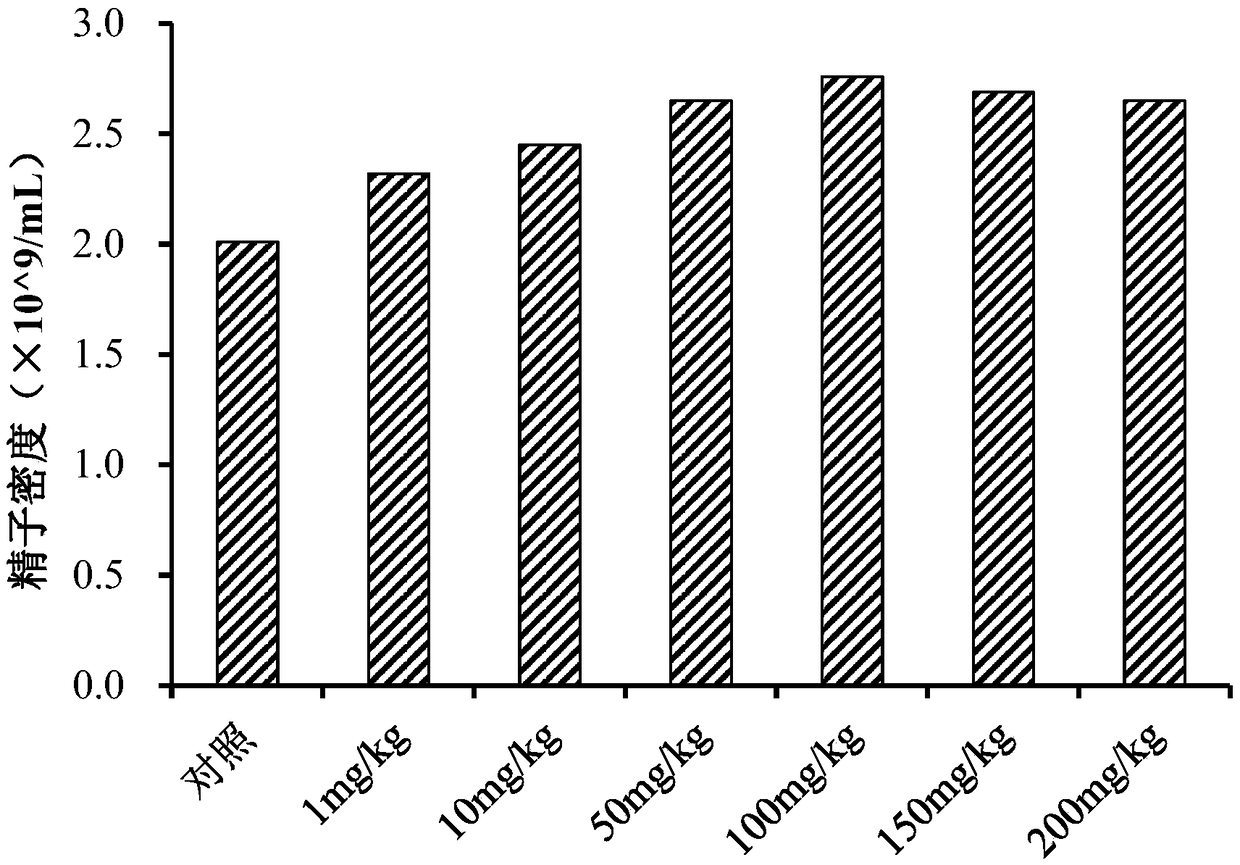Method for using castanea mollissima polysaccharides to improve animal semen quality
A technology of chestnut polysaccharide and semen is applied in the direction of animal feed, application, additional food elements, etc., to achieve the effects of improving reproductive system, improving semen quality, and improving semen quality.
- Summary
- Abstract
- Description
- Claims
- Application Information
AI Technical Summary
Problems solved by technology
Method used
Image
Examples
Embodiment 1
[0030] Embodiment 1: preparation chestnut polysaccharide
[0031] 1) Pick fresh and mature chestnuts, place them in an oven, dry them, peel them, crush and dry them with a grinder, degrease, pass through a 100-mesh sieve, weigh them, add ultra-pure water at a material-to-liquid ratio of 25g / L, and use a homogenizer Mix well, and then ultrasonically extract in an ultrasonic instrument with a power of 850W at 35°C for 1 hour;
[0032] 2) The extract obtained in step (1) was decolorized with activated carbon at 45°C for 1 hour, then the protein in the solution was repeatedly removed by the Sevage method, and then centrifuged at 11000r / min for 20 minutes, the precipitate was discarded, and the supernatant was recovered;
[0033] 3) Use a rotary evaporator to concentrate the supernatant obtained in step (2) until 80% of the supernatant is evaporated. At this time, the concentrated solution is precipitated with 100% alcohol, and the obtained precipitate is freeze-dried, and the obta...
Embodiment 2
[0036] Embodiment 2: Mouse feeding test
[0037] 210 3-week-old mice (with uniform body weight) of the healthy ICR strain were randomly assigned to 7 groups (30 / group). The mice were eating and drinking normally, and were raised in a unified SPF rat room . Take a certain amount of powder obtained in step 5) of Example 1 according to the design in Table 1 every day, convert the amount of powder needed to be used according to the amount of chestnut polysaccharide designed in the experimental group, dissolve it in purified water, and prepare the required chestnut polysaccharide solution. Each mouse was fed with chestnut polysaccharide solution matching its body weight by intragastric administration on time every day. Each mouse was gavaged with 0.1 mL chestnut polysaccharide solution. After 5 weeks of gavage, the semen of the mice was collected, and the sperm motility and density were analyzed with a semen quality analyzer. The test results are shown in Table 1:
[0038] Tabl...
Embodiment 3
[0041] Embodiment 3: Pig feeding test
[0042]In the cooperative experimental base of our school, 70 healthy weaned (40-day-old) boars were selected and randomly divided into 7 groups (10 heads / group). All pigs are in a large breeding room, eating and drinking normally, and are under unified management. Take a certain amount of powder obtained in step 5) of Example 1 according to the design in Table 2 every day, and convert the amount of powder that needs to be used according to the amount of chestnut polysaccharide designed in the experimental group. Fully mix the weighed animal concentrate and chestnut polysaccharide powder evenly. Feed the prepared feed concentrate containing chestnut polysaccharide to pigs on time every day. Feed until 6 months old, collect the semen of the pigs, and use the semen quality analyzer to analyze the sperm motility and density.
[0043] Table 2 Effect of pig supplementation with chestnut polysaccharide on semen quality
[0044] Dai...
PUM
 Login to View More
Login to View More Abstract
Description
Claims
Application Information
 Login to View More
Login to View More - R&D
- Intellectual Property
- Life Sciences
- Materials
- Tech Scout
- Unparalleled Data Quality
- Higher Quality Content
- 60% Fewer Hallucinations
Browse by: Latest US Patents, China's latest patents, Technical Efficacy Thesaurus, Application Domain, Technology Topic, Popular Technical Reports.
© 2025 PatSnap. All rights reserved.Legal|Privacy policy|Modern Slavery Act Transparency Statement|Sitemap|About US| Contact US: help@patsnap.com



